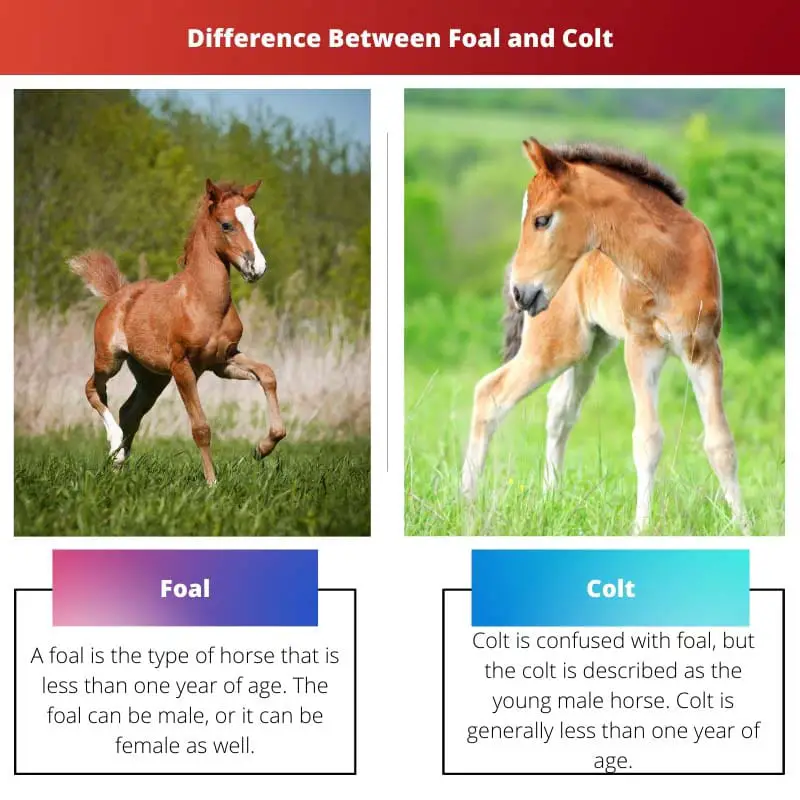The foal and colt are two different terminologies but are misunderstood. The term for horses evolves after ages. People overlook the significance of an animal’s age.
Key Takeaways
- A foal is a young horse of either gender, while a colt specifically refers to a young male horse.
- Foals are weaned from their mothers at around six months of age, while colts can be castrated at around one year of age.
- Foals and colts are trained for riding and other tasks, but colts may also be trained for breeding purposes.
Foal vs Colt
Foal is an equine up to a year old, but it is mostly used for horses and can be used to refer to donkeys. Male foals are called colts, while female foals are fillies. Colt is a young, uncastrated male horse that is less than four years old but becomes a stallion or a horse when it gets older.

The process is called suckling if the foal still has milk from her mother. The birth process of the foal is quite easy and takes only a few minutes on average.
It is called a female horse only if it has crossed the age of four years. Every colt is a foal because every male horse was once in a lifetime called a foal.
Comparison Table
| Parameters of Comparison | Foal | Colt |
|---|---|---|
| Age | The age of foal is less than one year of age | Colt is less than four years of age |
| Sex | The foal can either be male or female | Colt is a male horse |
| Relationship | Not all foals are colts | All colt can be foals |
| Level of Development | The initial stage of birth | Colt is considered as a later stage of a foal |
| Different Names | Nothing like this exists in the case of the foal | The young female horse is called a Filly, and the adult female horse is called a mare. |
What is Foal?
A foal is a type of horse that is less than one year of age. The foal can be male, or it can be female as well. The foal is used mainly for horses, but sometimes, this term is used for donkeys.
The healthy foals grow very quickly from three pounds to over a kilo a day. That is why to maintain the healthy weight of the foal. It is important to include solid food.
Foal grows very fast, but still, these animals are too young to be driven or ridden. That’s the reason the foals are given proper training by humans.

What is Colt?
Colt is confused with foal, but the colt is described as the young male horse. Colt is less than one year of age. The young female horse is called a filly and called a mare once it matures.
Colts are used in the horse racing world and are defined as young male horses aged between two and five years. Stallions are the type of horses that are left intact if they are used for breeding purposes.

Main Differences Between Foal and Colt
- The foal grows very fast, while the colt does not grow very fast.
- All colts are foals, as all the young male horses were foals once. In contrast, all the foals are not colts because fifty percent of foals are male while the rest are females.


I knew the basics, but this article taught me other things about the foal and colt that I didn’t know.
Yes, Amy. Perhaps the age-old term ‘colt’ is just so much more ingrained in our language and culture than ‘foal’.
Yes, Eileen. It´s surprising how these young male horses are used in the horse racing world.
It is actually surprising how many people don’t understand the differences between these terms.
The references here are quite interesting, worthy of further reading into this topic.
I find it quite ironic that so few people are able to differentiate between foals and colts.
Here is where the comparison table proves to be quite helpful.
I found the information about racing and breeding extremely insightful.
I think it’s important to look at the foal and colt as stages of development rather than just as divisons of gender.
That is correct, Toby. The text demonstrated effectively how the terms are different.
The fact that the process of suckling is clearly defined here makes this a very informative piece.
It’s an interesting topic, but I am still confused about some of the details on the birth process.